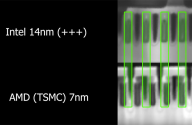Well according to this website the 7nm is in production and thru tear down and reverse engineering of sample they determine
it is 7nm
China’s SMIC Is Shipping 7nm Foundry ASICs
Dylan Patel
2 hr ago
SMIC, China’s largest foundry has slowly been catching up to TSMC, Samsung, and various western foundries in process technology. They are rapidly approaching position as the world’s 3rd largest foundry and have higher margins than the current number 3, GlobalFoundries. SMIC has achieved this through a combination of large subsidies from the state, poaching TSMC talent, and tremendous home-grown expertise. Their chips ship in large volumes to a variety of use cases from smartphones to . The foundry has now quietly released and started mass production of their 7nm process node dubbed N+2.
We say quietly as this didn’t come directly from SMIC, but rather the reverse engineering and teardown firm TechInsights who purchased the chip on the open market and sent it to their labs. SMIC likely has not discussed this publicly on earnings reports as they are afraid of blowback. To be abundantly clear, China’s SMIC is shipping a foundry process with commercially available chips in the open market which are more advanced than any American or European company. While the US has high hopes for Intel to be the savior, there are no Intel 7nm class foundry chips commercially available for purchase currently and they still have to build out their foundry operations. The most advanced American or European foundry produced chips are based on GlobalFoundries 12nm.
SMIC’s 7nm just like TSMC’s 7nm and Intel’s 7nm class technologies does not use EUV lithography. TechInsights has more information in their 3 detailed reports titled “ASIC Digital Floorplan Analysis,” “(SMIC 7nm) Advanced CMOS Process Analysis,” and “(SMIC 7nm) Process Flow Analysis.” We recommend people check those out for more details.
This is a groundbreaking discovery because the US Department of Commerce was supposed to be restricting export licenses for any equipment which can be used on technologies more advanced than 14nm. Of course, the department of commerce handed out export licenses like candy as they always do. Furthermore, almost all equipment that is used on SMIC’s 14nm FinFET can be used on their 7nm process technology as well. While SMIC likely cannot develop beyond 7nm without EUV, they still should be able to ramp their 7nm over time to very large volumes. The US government is asleep at the wheel as Lam Research off-shores production and Intel uses subsidies to import equipment used to manufacturer chips from China. Government policy is why the US will lose semiconductors.
SMIC’s foundry customer, MinerVa states this chip has been in production since July of 2021. On September 22nd 2021, MinerVa’s website was updated with information about the product and the image above. It is a small 19.3mm2 chip used for mining cryptocurrencies, but in the future, this process technology could be scaled up and adopted for high end supercomputer and consumer applications. Their miner ships with 120 chips per board with 3 board per miner and a total power consumption of 3300W.
Just FYI, the above discussion was about the same article posted earlier on the last page.
Chinese semiconductor industry
@olalavn Welcome, always good to have knowledgeable people here. What are your views on the status of SMEE's SSA800? it's just acceptance test, to develop photoresist and immersion device, it will officially launch in Q4 this year or Q1 next year...
www.sinodefenceforum.com
Last edited:


